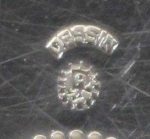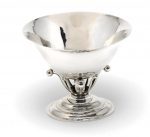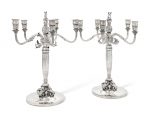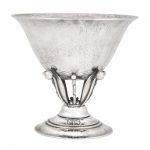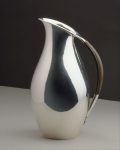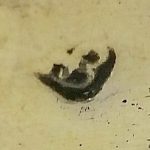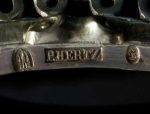Johan Rohde (1856-1935) was originally trained as a medical doctor and turned to arts quite late in life. After a few years of private studies, in 1881 he began his studies at the Royal Academy of Fine Arts in Copenhagen. Rohde was critical to the institutions stagnated view on art and its reluctance to accept modern currents, and within a year he had left the school.
The Academy’s refusal of modern art to the annual exhibitions held at Charlotteborg Palace lead to the establishment of the Free Exhibition in 1891, Rhode was one of the main initiators behind the founding of the association, along with Danish artists Vilhelm Hammershøi (1864-1916) and Theodor Philipsen (1840-1920).
Later Rhode turned to design and furniture, his furniture designs were often a mixture of Classicism and Japonism made of exotic timber, in 1900 several of his furniture were exhibited at the World’s Fair in Paris. He worked with silver concurrently with his furniture design. In 1906 he started his life long cooperation with Georg Jensen (1866-1935). Rhode became one of the first artists to design for the studio. In many ways Rhode is the designer whose work is most similar to Georg Jensen’s own designs with light spot-hammered surfaces and naturalistic influences, but unlike Jensen’s Art Nouveau inspired designs Rhode worked with more simplified geometric shapes and less ornaments. Several of his works represents simplicity, function and a respect for the material, that later would be the main features in Scandinavian design. Reference: Bonhams
JOHAN RHODE FOR GEORG JENSEN: A Danish silver bowl design 17A designed 1912, stamped with assay master mark for C F Heise, Copenhagen 1922 The bell-shaped bowl surmounted on vertical alternating foliate forms with berry finials, on stepped oval foot engraved presentation inscription, height 13.5cm, weight 10oz.
Sold for £ 937 inc. premium at Bonhams in 2014
Sauce boat; silver, hand-raised, with high scroll handle enclosing a disc
Factory of: Georg Jensen. Designed by: Johan Rohde
© The Trustees of the British Museum
A PAIR OF DANISH FIVE-LIGHT CANDELABRA MARK OF GEORG JENSEN AND WENDEL, 1945-1951, DESIGNED BY JOHAN ROHDE On a domed and circular base, the fluted and interlaced stem on four scroll supports, the scrolling branches with a spiral fluted central standard and dolphin finial, no. 224, marked under base 18 7/8 in. (48 cm.) high
Sold for GBP 75,000 at Christies in 2018
Johan Rohde for Georg Jensen Sterling Silver Footed Bowl Model no. 17, circa 1925-32 Height 4 inches, diameter 4 3/8 inches, approximately 5 ounces.
Sold for $468 (includes buyer’s premium) at Doyle New York in 2018
Johan Rohde Danish silver pitcher circa 1933
Reference: The Metropolitan Museum of Art
Johan Rohde was co-founder in 1891 of the secessionist group, Den Frie Udstilling (the Free Exhibition). Through this group he first met Georg Jensen, who in 1897 exhibited at Den Frie Udstilling the sculpture that had been rejected by the Danish Academy. Both later spent periods in the workshop of the silversmith Mogens Ballin, from which Jensen set up his own workshop in 1906. Rohde’s first silver designs, made in 1905 for his own house, were executed by Georg Jensen. He began to collaborate with Jensen in 1908, but it was not until 1917 that he entered into a formal association, which lasted until his death in 1935. During this time Rohde also designed silver for other Copenhagen firms. Reference: British Museum.
A set of eight Danish silver shot glasses #741, designed by Johan Rohde, Georg Jensen Silversmithy, Copenhagen, 1945-77 with openwork scroll stems marked on bases height 2 3/8 in. 6 cm 11 oz 342 g
Sold for 1,375 USD at Sothebys in 2018
